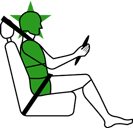Saab 9-3
|
Front and side impact rating |
 |
 |
 |
 |
 |
Pedestrian test rating |
 |
 |
 |
 |
Test Scores: Front 13(81%) Side 18(100%) Belt Reminder 2 Overall 33
Pedestrian 7(19%)
|
|

|
|
|
The SAAB 9-3 is
another to join the select band of cars good enough to deserve a full
five-star rating. It has been designed to keep its occupants safe. The
cabin around them, including the children, remained intact and its
restraint systems kept them from harm, although the driverís chest was
subjected to fairly high forces. The area that his knees would hit in a
crash was not clear but the only real hazard was a point beneath the
steering column. The car performed without fault in the side impact and
the pole test. Pedestrian protection was poor: the bonnet offered
cushioning at its centre but was stiff elsewhere. |

Impact
Protection
|
 |
|
 |
 |
 |
|
Driver Front
Impact |
Passenger
Front Impact |
Driver Side
Impact |
|

Frontal Impact
|
 |
|
|
The knee impact area
is particularly well planned, having a knee bolster that is designed to
collapse when struck hard. But testers found that the steering column
could transmit impact forces to the driverís knees. The footwell was not
deformed by the impact, posing few hazards to the driverís feet and
ankles. The front belts were fitted with load limiters and reel mounted
pre-tensioners. Even so, the driver suffered a high-ish chest loading.
The centre rear seat belt was of a three-point type, which provides much
better protection than that of a lap-only belt. |

Side Impact
|
 |
|
|
No points were lost
for its side impact performance, including the pole test. The curtain
airbag protected all occupants on the struck side. This deploys in
glancing frontal impacts where occupants may be be partly ejected as the
car rotates during impact. |

Child
Restraint
|
 |
|
|
Both restraints were
Saab branded and rear-facing, using the adult belts to secure their
fronts. The restraints used a support leg and belts to fix them to the
mounting for the front-seat floor rails. These restraints protected well
although some impact forces fed through to the older childís chest. If
the restraints must be fitted to the front passenger seat, Saab dealers
can disconnect the passengerís frontal airbag. |

Pedestrian
Protection
|
 |
|
|
The results here fall
far short of the carís achievements elsewhere. The bumper and bonnet
sides were particularly unfriendly to pedestrians, although the centre
of the bonnet would cushion them. |

Model history
and safety equipment
|
 |
|
|
The new 9-3 was
introduced during 2002. The í03 model year car includes dual frontal and
side airbags, head protection curtains, front belt pre-tensioners and
load limiters, a belt reminder system for both front seats and ISOFIX
anchor points on the outer rear seats. |
|
Make, model and
hand of drive |
Saab 9-3 2.0ltr LHD |
|
Body type |
4-door saloon |
|
Model year |
2003 |
|
Kerb weight |
1450 kg |
|
VIN and date when
rating applies |
all latest 9-3s |
|
Cars built on the
same platform |
none |
|
